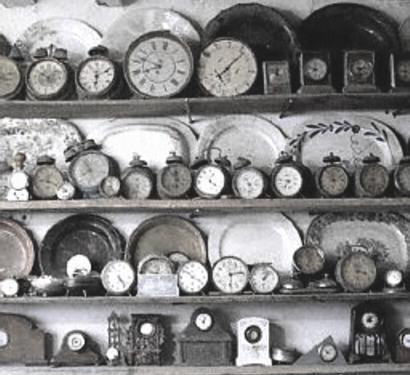


A picture, taken in 1919, of Margaux Brown's collection. It was at that time being stored and displayed in the pantry of the Brown house.



A picture, taken in 1919, of Margaux Brown's collection. It was at that time being stored and displayed in the pantry of the Brown house.
The Great Manchester Lump
HOC056881
Also known as Dali's Clock for obvious reasons; it is actually a
collection of clocks, rather than a single instrument.
There are 29 individual timepieces in the lump: all burnt and melted
together to form one large black mass. The lump (measuring about 5
feet high and 6 feet wide) was found in the Manchester area of England
in the 1950s. It probably dates back to 1779 when Mad King George III
placed a government tax on clocks and some drastic attempts were made
at destroying these suddenly expensive items. There is one feature of
the lump which to this day cannot be sufficiently explained. If you
insert a key into the 10 undamaged keyholes and wind the mechanisms
beneath, the lump works as if it were a single sympathetic object: the
hour-hand (more of an hour-stump now) on one dial, moves only when the
remaining minute-hand on another dial reaches its zenith, and a tick
from the right side of the lump is followed by a tock from the left. A
remarkable (and remarkably ugly) curiosity! -- Capt. S.S.Hendley
These were collected by Margaux Brown from a variety of sources (and corpses). They have no particular economic, spiritual or historical value but are presented in a single display case with all the relevant provinance (and some of the animals still attached) for no other purpose than good old-fashioned whimsy. Tigers, sharks and crocodiles devouring people and their watches are understandable everyday occurances and dimwitted goats swallowing clocks are not unimaginable scenarios. But can you explain the five foot long Moray Eel with the carriage clock in its stomach? And can the monkey rib-cage that is literally fused to the silver pocket watch be anything other than a fraudulent sideshow exhibit? The most interesting exhibits in this display case are arguably the x-ray pictures showing the Indian Railwaymans Timepiece inside an Elephant's skull and the alarm clock that Margaux brought from Mr. J. M. Barrie, which was made famous in the book that Mr. Barrie published in 1904 about delinquent children learning to fly.
-- Capt. S.S. Hendley
Seven Chronologically Displaced Pocketwatches
HOC27301
Seven sterling silver pocket watches, each of them the property of the
absent-minded Sir Rupert Spencer, noted explorer and "time-tourist".
Alike in appearance, closer inspection reveals that their similarity runs
deeper than mere design. They each bear Spencer's scratched initials,
the lettering so distinctive, and so identical on each, as to place it
beyond doubt that they are in fact the very same watch.
Discovered at various times throughout four centuries, in locales as
familiar as Lincoln Park Zoo and as remote as a Delhi lake bed, all that
distinguishes an individual watch from its fellows is the amount of wear
and tear on each. From their increasingly scratched and dented condition
one might place them in order, and thus construct a map of their owner's
escapades, zig-zagging back and forth through time and space, an erratic
journey which occasions the watch's multiple appearance in our current
age.
At some future point Sir Spencer will visit the House and claim the first
watch in the sequence, its casing almost flawless. It will then be lost
on the platform of Michigan Central Station in 1934, found and brought to
the House later, becoming the second watch in the display. Sir Spencer
will return once more to claim it, subsequently misplacing the piece
during his jaunt to the Carpathian mountains in 1732. Again it will find
its way back to the House sometime thereafter, thence becoming the third
in the sequence. And so it goes, the watch's temporal trajectory looping
sevenfold upon itself, Spencer returning to claim it each time until
finally only a single piece will remain. The last in the display; its
casing cracked and its face shattered, blood dried into its crevices,
suggesting that its owner has an appointment with some frightful accident
in the Bucharest salt mine where it was discovered.
The implication that there are numerous versions of Sir Spencer on the
loose throughout history, each of them without a convenient method of
keeping time, is supported by his appearance in a photograph taken during
the construction of the Brooklyn Bridge, fourteen years before his birth.
The gentleman chrononaut can be seen in the middle-background, his hand
reaching into his breast pocket, an expression of perplexity etched on his
face. -- Mordecai Mulroney
 History |
 Exhibits |
 Collections |
 Directions |
 Tickets |
 Shop |
 Guestbook |
 Publications |